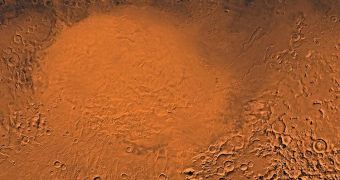Astronomers are currently considering the possibility that a massive asteroid impact that occurred sometime in the distant past was responsible for destroying Mars' magnetic field. Theoreticians are currently trying to determine whether such a scenario is even possible.
There are several massive craters on the Red Planet, one of which could easily swallow Mount Everest in its entirety. There are also important canyon regions, such as Valles Marineris, which display interesting geological properties.
According to currently-available data, it would appear that our neighboring planet lost its protective magnetic field – and its magnetosphere along with it – during an event that occurred some 500 million years ago, Daily Galaxy reports.
A group of experts at the American space agency believe that an asteroid impact is a very likely explanation for this disappearance. It's not as if a planet can lose its magnetic properties overnight, during a very brief interval.
There are also objective reasons for why a space impact makes sense as a possible explanation. For starters, the “full range of topography on Mars is about 19 miles (30 kilometers), one and a half times the range of elevations found on Earth,” Dr. David Smith explains.
The NASA Goddard Space Flight Center (GSFC) expert was the principal investigator of the Mars Orbiter Laser Altimeter (MOLA) instrument, on the now-defunct NASA Mars Global Surveyor orbiter.
“The most curious aspect of the topographic map is the striking difference between the planets low, smooth Northern Hemisphere and the heavily cratered Southern Hemisphere,” he goes on to say.
What MOLA data suggest is that the northern landscape was shaped by naturally occurring tectonic processes, whereas vast portions of the planet's southern hemisphere were produced, or at least shaped, by external factors, such as asteroids or meteorites.
Space impactors would not act through sheer force on a planet, scientists believe. Rather, repeated impact from large objects would heat up the mantle. This is the planetary layer between the core and the crust.
Without the core-mantle heat difference to drive a dynamo effect via convection forces, the phenomena generating magnetism would have stopped, leaving the surface of Mars exposed to space and solar radiations.

 14 DAY TRIAL //
14 DAY TRIAL //